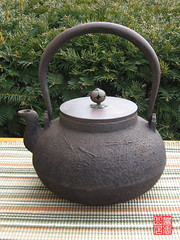

 The first time this motif caught my eyes was when I bought a tetsubin with kanji 松風(wind through pine trees) on one side and some "strange" design on the other. At that time, I wasn't sure that the needle like leaves are pine needles and the fruit like thing is a pine cone. Later on I learned that this motif is called 松葉絵 matsu-e(drawing of pine needles). Sometimes, pine cones, called 松ぼっくり(松毬), are also accompanied.
The first time this motif caught my eyes was when I bought a tetsubin with kanji 松風(wind through pine trees) on one side and some "strange" design on the other. At that time, I wasn't sure that the needle like leaves are pine needles and the fruit like thing is a pine cone. Later on I learned that this motif is called 松葉絵 matsu-e(drawing of pine needles). Sometimes, pine cones, called 松ぼっくり(松毬), are also accompanied.Two things we can learn from this motif. First, as the pine leaves are depicted not on branch but as separate pairs of needles, this motif indicates the season to be late autumn, when the pines shed some leaves on the ground. The falling leaves, just as the falling of sakura flower in Spring, give a sense of the transient beauty. Second, as the needles are paired, or in fascicles of two, we can tell that the dominant pines trees in Japan are probably those similar to Red Pines or Scots Pines in Europe. Or, at least these are the pines that caught the artists' eyes...
The following are a few more examples of the pine needles motif on Japanese tea wares. Note the first one, a tea caddy, has both needles and pine cone, similar to the tetsubin. The second one, a red tea caddy, has bamboo leaves and plum flowers -- thus it makes another popular motif Sho-chiku-bai (松竹梅 pine-bamboo-plum), or Saikan Sanyuu (歳寒三友), literally, "the Three Friends of Winter."




This is a 松葉絵銘々皿 (matsuba-e-meimeizara; "meimeizara" are small plates for individual helpings of food) and it has a more realistic depiction of the pine needles --
